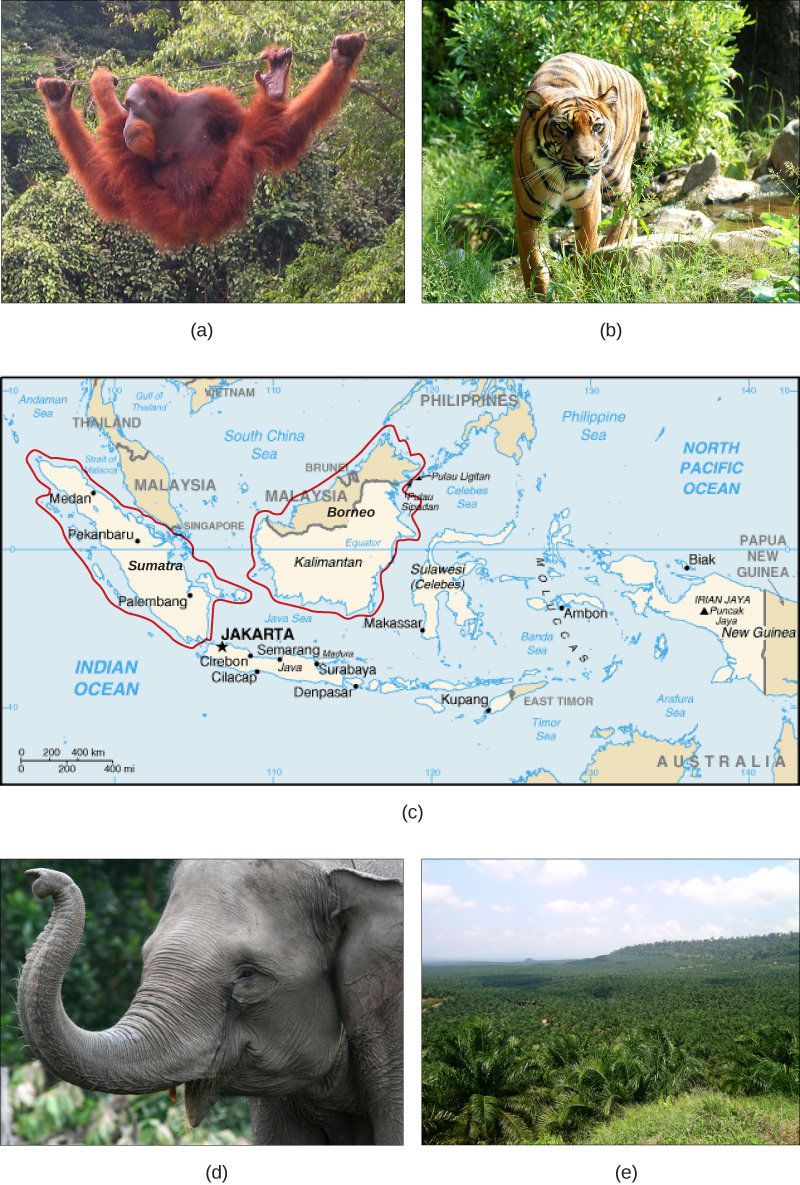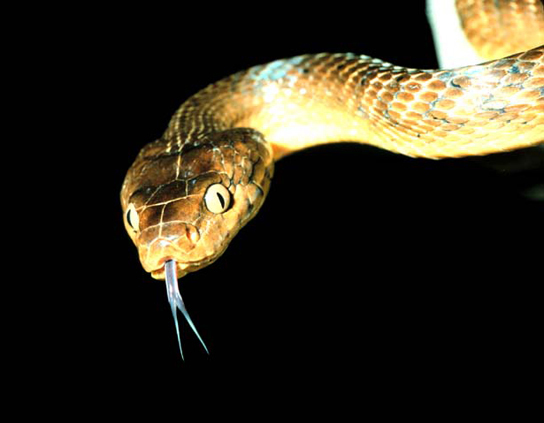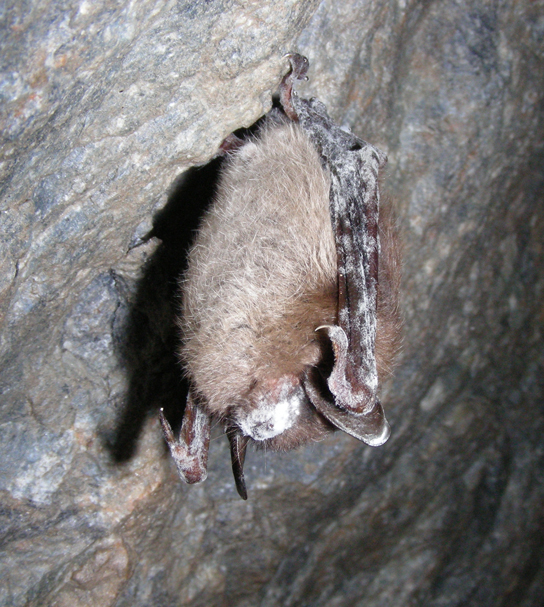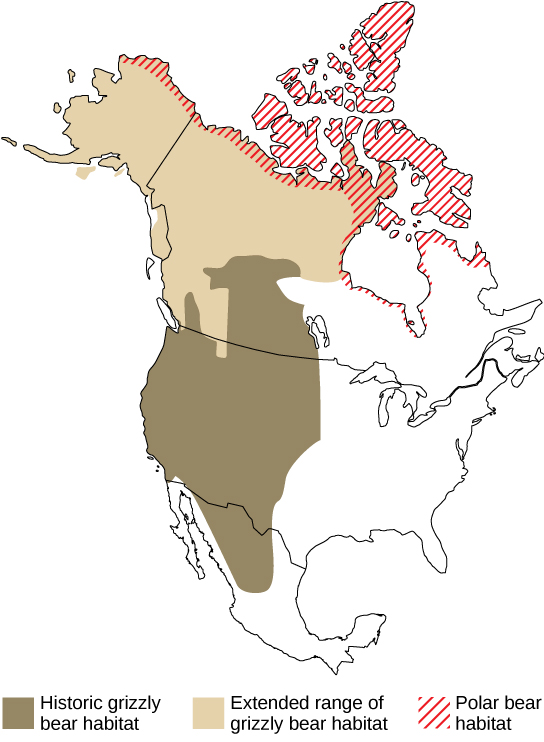47.3: 对生物多样性的威胁
- Page ID
- 202905
培养技能
- 识别生物多样性面临的重大威胁
- 解释栖息地丧失、外来物种和狩猎对生物多样性的影响
- 确定气候变化对生物多样性的早期和预测影响
对地球生物多样性的核心威胁,因此也是对人类福祉的威胁,是人口增长和资源开采的结合。 人类需要资源才能生存和增长,而这些资源正以不可持续的方式从环境中消失。 生物多样性面临的三大直接威胁是栖息地的丧失、过度捕捞和外来物种的引进。 前两个是人口增长和资源使用的直接结果。 第三个原因是流动性和贸易的增加。 导致灭绝的第四个主要原因是人为气候变化,尚未产生重大影响,但预计将在本世纪产生重大影响。 全球气候变化也是人口对能源的需求以及使用化石燃料来满足这些需求的结果(图\(\PageIndex{1}\))。 有毒污染等环境问题对物种具有特定的针对性影响,但通常不像其他问题那样被视为威胁。

栖息地丧失
人类依靠技术来改变环境,取代曾经由自然生态系统执行的某些功能。 其他物种无法做到这一点。 消灭它们的生态系统,无论是森林、沙漠、草原、淡水河口还是海洋环境,都会杀死该物种中的个体。 移除物种范围内的整个栖息地,除非它们是为数不多的在人造环境中表现良好的物种之一,否则该物种将灭绝。 二十世纪下半叶,人类对栖息地的破坏加速了。 以苏门答腊卓越的生物多样性为例:这里有一种猩猩、一种极度濒危的大象和苏门答腊虎,但苏门答腊一半的森林现在已经消失了。 邻近的婆罗洲岛是其他种类的猩猩的家园,已经失去了类似的森林面积。 婆罗洲保护区的森林流失仍在继续。 婆罗洲的猩猩被国际自然保护联盟(IUCN)列为濒危物种,但它只是成千上万种在婆罗洲森林消失后无法幸存下来的物种中最明显的一种。 森林被砍伐用于木材和种植棕榈油种植园(图\(\PageIndex{2}\))。 在欧洲,棕榈油用于许多产品,包括食品、化妆品和生物柴油。 据估计,2000-2005年的五年全球森林覆盖面积损失为3.1%。 在潮湿的热带地区,森林流失主要来自木材开采,在全球总面积11,564,000平方公里(占2.4%)中,损失了27. 2 万平方公里。 在热带地区,这些损失无疑也意味着物种的灭绝,因为特有性很高。

日常连接:通过明智的木材选择防止栖息地的破坏
大多数消费者并不认为他们购买的家居装修产品可能会导致栖息地的丧失和物种灭绝。 然而,非法采伐的热带木材市场巨大,木制品经常出现在美国的建筑用品商店里。 据估计,美国是世界上最大的木制品消费国,进口的木材流中有10%可能是非法采伐的。 2006年,这相当于木制品的36亿美元。 大多数非法产品是从充当中间商的国家进口的,不是木材的原产国。
如何确定地板等木制品是否以可持续方式甚至合法采伐? 森林管理委员会(FSC)对可持续采伐的林业产品进行认证,因此,寻求地板和其他硬木产品的认证是确保木材不会被非法从热带森林中非法开采的一种方法。 认证适用于特定产品,不适用于生产商;一些生产商的产品可能没有认证,而其他产品则经过认证。 尽管除了FSC之外还有其他行业支持的认证,但由于缺乏对行业的独立性,这些认证不可靠。 另一种方法是购买国产木材。 虽然如果有一份合法和非法木制品的清单会很好,但这并不是那么简单。 伐木和森林管理法律因国家而异;在一个国家非法的东西在另一个国家可能合法。 产品的采伐地点和方式,以及其来源的森林是否得到可持续维护,所有这些因素都决定了木制品是否会获得FSC的认证。 询问有关木制品来自何处以及供应商如何知道它是合法采伐的问题总是一个好主意。
栖息地的破坏会影响森林以外的生态系统。 河流和溪流是重要的生态系统,经常通过土地开发、筑坝或清除水来改变。 河流筑坝会影响水流和进入河流各个部分的通道。 不同的流量模式可以减少或消灭适应这些流动模式变化的人口。 例如,据估计,美国有91%的河流长度已经开发:它们进行了改造,例如修建水坝,以产生能源或储存水;修建堤坝,以防止洪水;或者疏浚或改道,以创造更适合人类发展的土地。 美国的许多鱼类,尤其是稀有物种或分布受限的物种,都因河流筑坝和栖息地丧失而减少。 研究证实,必须在水生和陆地栖息地中完成部分生命周期的两栖动物物种更有可能遭受种群减少和灭绝,因为它们的栖息地之一或它们之间的通道丧失的可能性增加。
过度采摘
过度捕捞对许多物种构成严重威胁,尤其是对水生物种构成严重威胁。 有许多例子表明,渔业科学家监测的受监管的商业渔业已经崩溃。 西大西洋鳕鱼捕捞是最近最引人注目的崩溃。 尽管它在400年中一直是一种生产率很高的渔业,但1980年代引进的现代化工厂拖网渔船以及对渔业的压力使它变得不可持续。 渔业崩溃的原因既是经济的,也是政治性的。 即使捕鱼区位于一个国家的领海内,大多数渔业也是作为共同(共享)资源进行管理的。 共同资源受到被称为 “公地悲剧” 的经济压力的影响,在这种压力下,基本上没有一个渔民有动力在捕捞不是该渔民所有的情况下在捕捞渔业时实行克制。 收获共同拥有的资源的自然结果是过度开发。 尽管对大型渔业进行监管以避免这种压力,但它仍然存在于后台。 如果捕鱼渠道开放、不受管制,当技术使渔民有能力过度捕捞时,这种过度开发就会加剧。 在一些渔业中,如果将时间和金钱投资到其他地方,资源的生物增长低于捕鱼所得利润的潜在增长。 在这种情况下(鲸鱼就是一个例子),经济力量总是会驱使捕鱼种群灭绝。
在大多数情况下,渔业灭绝并不等同于生物灭绝——一个物种的最后一条鱼很少从海里捕捞出来。 同时,渔业灭绝仍然对鱼类物种及其生态系统有害。 在某些情况下,真正的灭绝是可能的。 鲸鱼种群增长缓慢,有因狩猎而完全灭绝的危险。 有些种类的鲨鱼分布有限,有灭绝的危险。 石斑鱼是另一种通常生长缓慢的鱼类种群,在加勒比地区,包括许多因过度捕捞而面临灭绝风险的物种。
珊瑚礁是极其多样化的海洋生态系统,面临着多种过程的危险。 尽管珊瑚礁仅占海洋栖息地的1%,但珊瑚礁是世界上三分之一的海洋鱼类物种(约4,000种)的家园。 大多数家庭海洋水族馆都存有野生捕获的生物,而不是培养的生物。 尽管已知没有任何物种因海洋物种的宠物贸易而灭绝,但有研究表明,一些物种的数量因捕捞而减少,这表明在这些水平上收获是不可持续的。 有人担心宠物贸易对某些陆地物种的影响,例如海龟、两栖动物、鸟类、植物甚至猩猩。
丛林肉是通用术语,用于指为食物而杀死的野生动物。 世界各地都在进行狩猎,但狩猎习惯,特别是在赤道非洲和亚洲部分地区,据信会威胁到几种物种的灭绝。 传统上,非洲的丛林肉是用来直接养活家庭的;但是,最近这种做法的商业化现在可以在杂货店买到丛林肉,这使收获率提高到了不可持续的程度。 此外,人口增长增加了对农业无法满足的蛋白质食物的需求。 受到丛林肉类贸易威胁的物种主要是哺乳动物,包括生活在刚果盆地的许多灵长类动物。
外来物种
外来物种是指人类有意或无意地引入其未进化的生态系统的物种。 这种引入很可能经常作为自然现象发生。 例如,原产于日本的葛根(Pueraria lobata)于 1876 年引入美国。 后来,它被种植用于水土保持。 问题是,它在美国东南部生长得太好了——每天可达一英尺。 它现在是一种害虫物种,在美国东南部占地超过700万英亩。 如果引进的物种能够在其新栖息地生存,那么这种引进现在会反映在该物种的观测范围内。 人类运送人员和货物,包括故意运输生物进行贸易,极大地增加了将物种引入新生态系统的机会,有时距离远远超出物种本身旅行的能力,也超出了该物种的范围自然捕食者。
大多数外来物种的引入失败可能是因为引进的个体数量少或对它们进入的生态系统的适应性差。 但是,有些物种具有预适应能力,可以使它们在新的生态系统中特别成功。 这些外来物种在新栖息地的种群经常急剧增加,并在新环境中重启生态条件,威胁到那里存在的物种。 因此,外来物种也被称为入侵物种。 外来物种可以通过争夺资源、捕食或疾病来威胁其他物种。
湖泊和岛屿特别容易受到引进物种的灭绝威胁。 如前所述,在维多利亚湖,故意引入尼罗河鲈鱼是造成约200种慈鲷灭绝的主要原因。 通过飞机意外引入棕树蛇(图\(\PageIndex{3}\)) from the Solomon Islands to Guam in 1950 has led to the extinction of three species of birds and three to five species of reptiles endemic to the island. Several other species are still threatened. The brown tree snake is adept at exploiting human transportation as a means to migrate; one was even found on an aircraft arriving in Corpus Christi, Texas. Constant vigilance on the part of airport, military, and commercial aircraft personnel is required to prevent the snake from moving from Guam to other islands in the Pacific, especially Hawaii. Islands do not make up a large area of land on the globe, but they do contain a disproportionate number of endemic species because of their isolation from mainland ancestors.

It now appears that the global decline in amphibian species recognized in the 1990s is, in some part, caused by the fungus Batrachochytrium dendrobatidis, which causes the disease chytridiomycosis (Figure \(\PageIndex{4}\)). There is evidence that the fungus is native to Africa and may have been spread throughout the world by transport of a commonly used laboratory and pet species: the African clawed toad (Xenopus laevis). It may well be that biologists themselves are responsible for spreading this disease worldwide. The North American bullfrog, Rana catesbeiana, which has also been widely introduced as a food animal but which easily escapes captivity, survives most infections of Batrachochytrium dendrobatidis and can act as a reservoir for the disease.

Early evidence suggests that another fungal pathogen, Geomyces destructans, introduced from Europe is responsible for white-nose syndrome, which infects cave-hibernating bats in eastern North America and has spread from a point of origin in western New York State (Figure \(\PageIndex{5}\)). The disease has decimated bat populations and threatens extinction of species already listed as endangered: the Indiana bat, Myotis sodalis, and potentially the Virginia big-eared bat, Corynorhinus townsendii virginianus. How the fungus was introduced is unclear, but one logical presumption would be that recreational cavers unintentionally brought the fungus on clothes or equipment from Europe.

Climate Change
Climate change, and specifically the anthropogenic (meaning, caused by humans) warming trend presently underway, is recognized as a major extinction threat, particularly when combined with other threats such as habitat loss. Scientists disagree about the likely magnitude of the effects, with extinction rate estimates ranging from 15 percent to 40 percent of species committed to extinction by 2050. Scientists do agree, however, that climate change will alter regional climates, including rainfall and snowfall patterns, making habitats less hospitable to the species living in them. The warming trend will shift colder climates toward the north and south poles, forcing species to move with their adapted climate norms while facing habitat gaps along the way. The shifting ranges will impose new competitive regimes on species as they find themselves in contact with other species not present in their historic range. One such unexpected species contact is between polar bears and grizzly bears. Previously, these two species had separate ranges. Now, their ranges are overlapping and there are documented cases of these two species mating and producing viable offspring. Changing climates also throw off species’ delicate timing adaptations to seasonal food resources and breeding times. Many contemporary mismatches to shifts in resource availability and timing have already been documented.

Range shifts are already being observed: for example, some European bird species ranges have moved 91 km northward. The same study suggested that the optimal shift based on warming trends was double that distance, suggesting that the populations are not moving quickly enough. Range shifts have also been observed in plants, butterflies, other insects, freshwater fishes, reptiles, and mammals.
Climate gradients will also move up mountains, eventually crowding species higher in altitude and eliminating the habitat for those species adapted to the highest elevations. Some climates will completely disappear. The rate of warming appears to be accelerated in the arctic, which is recognized as a serious threat to polar bear populations that require sea ice to hunt seals during the winter months: seals are the only source of protein available to polar bears. A trend to decreasing sea ice coverage has occurred since observations began in the mid-twentieth century. The rate of decline observed in recent years is far greater than previously predicted by climate models.
Finally, global warming will raise ocean levels due to melt water from glaciers and the greater volume of warmer water. Shorelines will be inundated, reducing island size, which will have an effect on some species, and a number of islands will disappear entirely. Additionally, the gradual melting and subsequent refreezing of the poles, glaciers, and higher elevation mountains—a cycle that has provided freshwater to environments for centuries—will also be jeopardized. This could result in an overabundance of salt water and a shortage of fresh water.
Summary
The core threats to biodiversity are human population growth and unsustainable resource use. To date, the most significant causes of extinctions are habitat loss, introduction of exotic species, and overharvesting. Climate change is predicted to be a significant cause of extinctions in the coming century. Habitat loss occurs through deforestation, damming of rivers, and other activities. Overharvesting is a threat particularly to aquatic species, while the taking of bush meat in the humid tropics threatens many species in Asia, Africa, and the Americas. Exotic species have been the cause of a number of extinctions and are especially damaging to islands and lakes. Exotic species’ introductions are increasing because of the increased mobility of human populations and growing global trade and transportation. Climate change is forcing range changes that may lead to extinction. It is also affecting adaptations to the timing of resource availability that negatively affects species in seasonal environments. The impacts of climate change are greatest in the arctic. Global warming will also raise sea levels, eliminating some islands and reducing the area of all others.
Art Connections
Converting a prairie to a farm field is an example of ________.
- overharvesting
- habitat loss
- exotic species
- climate change
- Answer
-
B
Glossary
- bush meat
- wild-caught animal used as food (typically mammals, birds, and reptiles); usually referring to hunting in the tropics of sub-Saharan Africa, Asia, and the Americas
- chytridiomycosis
- disease of amphibians caused by the fungus Batrachochytrium dendrobatidis; thought to be a major cause of the global amphibian decline
- exotic species
- (also, invasive species) species that has been introduced to an ecosystem in which it did not evolve
- tragedy of the commons
- economic principle that resources held in common will inevitably be overexploited
- white-nose syndrome
- disease of cave-hibernating bats in the eastern United States and Canada associated with the fungus Geomyces destructans




